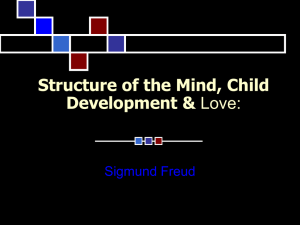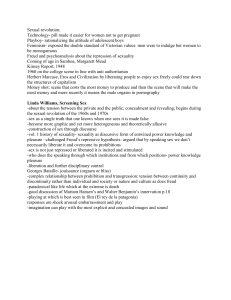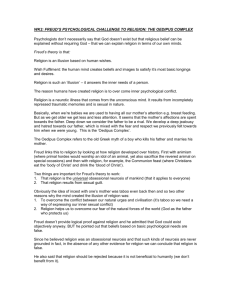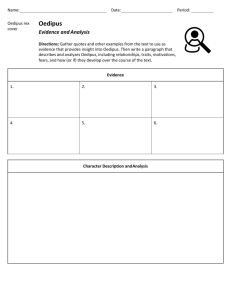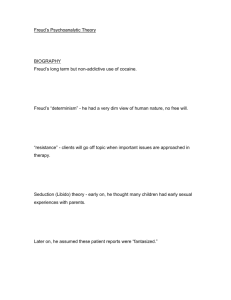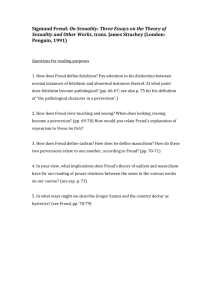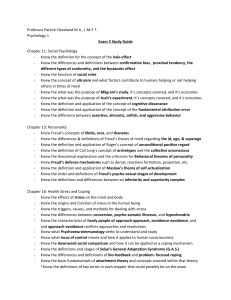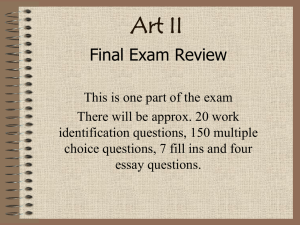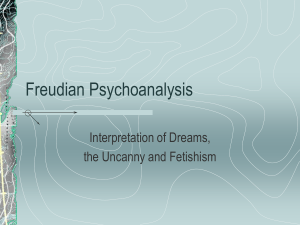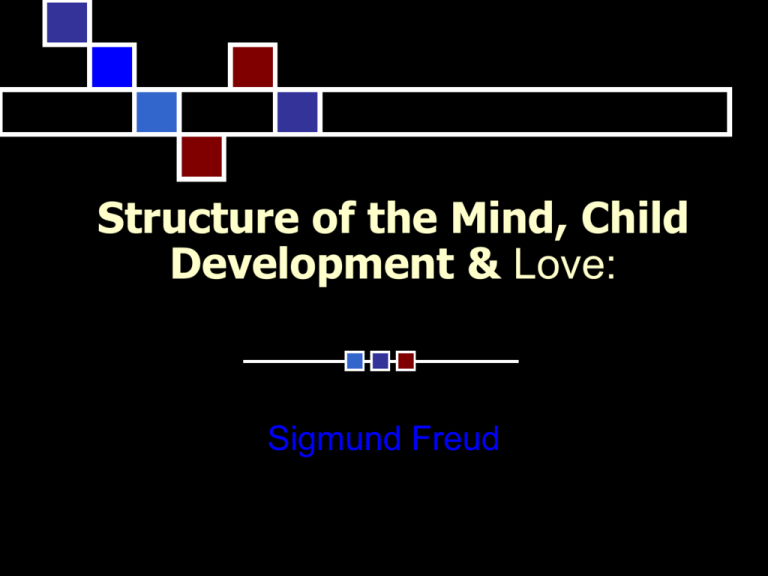
Structure of the Mind, Child
Development & Love:
Sigmund Freud
Section II: Psychoanalytic
Approaches to Self & Literature
(covered in our course)
(1)
(2)
(3)
(4)
Structure of the Mind, Child
Development & Love
Dream and Sexual Symbols
Lacan’s Views of Desire & Split Identity
Psychological Disorders
Outline
Starting Questions & Key Words
Freud’s Premise
1.
2.
3.
Psyche; an example
Sexuality, Love and Desire
Child Development, Repression and
Sublimation
Issues and Discussion
Examples: 1) Literature and Fine Arts; 3)
Dali, 4) “Eveline”
(assignment
for next week)
Starting Questions
Are we rational or autonomous? How is our
body related to our mind –and soul? Can the
latter two transcend the former? Or are they
formed by it and also in resistance to it?
What are Freud’s theories of human psyche (or
mind) and sexuality? Do you agree with them?
Is intimate love definitely sexually driven?
Should our sexual desires be repressed or
liberated? Can college girls stay over at man’s
dorms?
Have you experienced Oedipus/Electra complex
and/or castration fear?
Key Words
Sexuality, libido, pleasure principle
id, ego, superego,
Reality principle, Repression and
sublimation
child development: Erotogenic zones,
oral, anal and genital phases;
Oedipus/Electra complex, castration fear
Freud: Three Premises
1. most of the individual's mental
processes are unconscious.
2. all human behavior is motivated
ultimately by what we would call sexuality.
The prime psychic force is libido, or
sexual energy.
3. Because of the powerful social taboos
attached to certain sexual impulses, many
of our desires and memories are
repressed.
The Unconscious
--cannot be pointed at; can only be
"diagnosed."
--the reverse of consciousness; takes a
large part of our mind.
Making itself manifest through "gaps"-unintended lapses in memory, slips of
tongue, puns and dreams tip of an
iceberg
Our Psyche: three models
(textbook pp. 149-51)
More and more specific descriptions of our
mind:
1. Dynamic: the interplay of forces within
the mind, or the tensions that develop
when instinctual drives meet the
necessities of external reality
formation of the mind out of the body
and its experience of pleasure and pain
2. Economic: For self-preservation, ego
negotiates between “pleasure principle”
and “reality principle”
Our Psyche: three models (2)
(textbook pp. 149-51)
3. Topographic (地形) –2 kinds of three-fold
division
The conscious – perceptual or sensory
consciousness which orders reality;
the preconscious –the elements of
experience which can be called into
consciousness;
the unconscious– desires, images and ideas
unknown to and repressed by us.
Our Psyche: Topographic model (2)
Superego
morality p.
repository of
conscience &
pride
Follows reason
and morality
circumspection
protect society
e.g. internalized
parental discipline
• Ego
•reality p
•Intermediary
• protects one’s
self
•e.g. restrain
from crying in
order to get
what it wants
Id
pleasure p.
repository of
libido
Follows instinct
and passion
self-satisfaction
e.g. babies’
non-stop crying
Example I: “No Problem”
Desire for a female
-- Fantasies:
1) aerobic teacher;
2) Zolga.
Example I: “No Problem”
– Attempts frustrated
1) visits with a bunch of flowers –nervous,
2) conflicting desires
Example I: “No Problem”
2) conflicting desires
Example I: “No Problem”
In between the conflicting two:
Messy, likes to eat, sex-driven;
Polite, cautious, prohibiting.
Example I: “No Problem”
Images and their symbolic meanings:
water dripping down his face, rain, waterfalls,
embarrassment, obstacles, insatiable desire;
closing door
Images and their symbolic
meanings:
black dog, foods
Solution:
Killing the two;
Combining the three;
Closing the door against the dog.
Freud’s View of Sexuality and
Love (Singer 100-)
1) love as the fusion of sexuality and
tenderness.
Tenderness and affection directed toward the
ones who take care of the baby;
Two currents fused only in early childhood;
hardly combined in adulthood.
There is always a yearning for a confluence
of these two currents. (// Lacan’s idea of
desire as lack.)
Freud’s View of Sexuality and
Love 2 (Singer 100-)
2) Love as libidinal energy;
Libido = energy, “dynamic manifestation of
sexuality.”
Freud’s idea of Sexuality is broader than the
general conception:
It includes not just adult coital sex,
but also “the sexual life of perverted persons and
also of children.”
Perversion= sexual but not genital activities.
Children—polimorphous,
The Pervert – fixated on non-genital love objects
which “normal” people have outgrown.
Freud’s View of Sexuality and
Love 3 (Singer 100-)
3) Love as Eros
The drive or instinct of life which attaches
individuals to each other and ultimately
unifies mankind;
4) Love as the mixture of Eros and one’s
aggressive instinct (death drive).
Almost every intimate relationship between
two people which lasts for some time
leaves a sediment of feelings of aversion
and hostility. (Singer 114) Agree?
Child development
oral stage
anal stage
latent period
phallic stage
genital stage
What is happening in this process ... is a gradual
organization of the libidinal drives . . .
Oedipus complex and gendering process
With Oedipus complex starts the process of
socialization
Child development (2)
1. oral stage
(sucking)
2. anal stage
(withholding, expulsion)
3. phallic stage
(castration complex)
4. latent period
5. genital stage
Auto-eroticism
Oedipus complex
(positive and negative
constellation)
puberty
Oedipus complex
Oedipus complex in
Boys
Loving Mother, Hating
father
Castration fear
Positive constellation:
identifies with Father,
later loves other women
Negative constellation:
identifies with Mother
and loves Father or
unable to love other
women.
Electra complex in Girls
loving Mother
loving Father + Penis envy
Loving Father and
identifying with Mother in
order to produce babies
for Father.
Negative: unable to love
Father or other men.
Repression and Sublimation
Libido as flows of energy.
Once held back (as if water being
dammed up), it has to find other outlets.
Two possible outcome –
sublimation, (indirect expressions in Dream
or Art)
The return of the repressed.
“All the achievements of civilization result from
the discharge of sublimated energy.” (Singer 103)
// Civilization and its Discontents.
fixation (e.g. neurosis, perversion such as
fetishism)
Summary: Freud’s Major
Concepts
The Unconscious & Structure of the
psyche
the child's sexual development-a. polymorphous sexuality, three stages,
fixation
b. Oedipal stage--gendering process,
Oedipus complex, castration fear
dream analysis--condensation,
substitution, symbolization
repression and pyschological disorder:
psychological or physical abnormalities as
symptoms (or covert expressions of
desire)biography
Key Issues in Freud’s views of
sexuality & Oedipus complex
Recognition of Father’s authority
Development from bi-sexuality to
heterosexuality
The influence of sexuality, parents and
childhood on our personality
Are we born to be destructive and
aggressive? Is sexuality the source of
our energy?
Child development (3)
Beyond Freud
Pre-Oedipal
Symbiosis
(Identification
with Mother)
Oedipus
complex &
its
resolution
Transitional Objects
(Object-Relation
Theory) e.g.
receiving blanket
Examples of Freud’s
Oedipus complex
Sons and Lovers –Paul not able to
love the woman who resembles his
mother.
Peter Pan –as Wendy’s Other (with
phallic power)
Leonardo –his androgenous figures
“Araby” – the child in lack of maternal
love.
Edgar Allan Poe (next week)
Example: SALVADOR DALI
His stylistic concerns: eroticize reality
+ Trompe-l'oeil
'After Freud it is the outer world, the
world of physics, which will have to
be eroticized and quantified.‘ Dali,
IN 'THE WORLD OF SALVADOR
DALI,' MACMILLAN 1962
(source: SALVADOR DALI http://www.mmlab.ktu.lt/Dali/index.html )
Example: SALVADOR DALI
"My whole ambition in the pictorial
domain is to materialize the images
of concrete irrationality with the
most imperialist fury of precision."
"to systematize confusion and
contribute to the total discrediting of
the world of reality"
Example: SALVADOR DALI
His Life
Gala and Dali met in the summer of 1929. In
that year, Dali's paintings were full of flourishing
sexual symbols. "This historic meeting was
accompanied by a fit of extreme madness. Dali
was in such a state of constant exaltation that
every time he started to speak to Gala he burst
into insane laughter" (Neret, 22).
“The Great Masturbator” bears witness to
Dali's first encounter with Gala and the state in
which she left him-midway between 'hard' and
'soft'" (Neret, 28).
The Great Masturbator
"The Great Masturbator" is one of Dali's
classic surreal images of sexual
persecution and an obsession with
castration, impotence, and masturbation.
It is also an image that plays off of
psychic automatism and Freudian dream
logic: displacement, condensation, and
fetish. (source)
Where do we see displacement,
condensation and fetish?
Language of Dream
Fetish: A tremendous nose -leaning on the ground
A large, soft, terrorized
head, livid and waxlike, with
pink cheeks; the closed
eyes (embellished by very
long eyelashes) suggest the
state of sleeping or
dreaming.
Condensation:Metamorpho
sis at the neck region
The mouth, replaced by a decaying
grasshopper crawling with ants.
Example 2: “Eveline”
Recurring images in The Dubliners: death,
disintegration of community, degradation of
religion, liquor, constraint to the degree of
paralysis. Do you see them in this story?
Why can’t she leave with Frank? What is
he associated with? What roles does her
mother and father play in her life?
“Eveline”: Images of Decay and
Constraint
Death – of people, Dust (cretonne),
Change – good old past, the priest gone,
field built with houses (with bright bricks,
shining roofs vs. their brown houses)
Constraint – window, people’s comments,
father’s control
Hard life and work
“Eveline”: No Escape
Frank
–represent the remote, the open and free, and
“romantic” (Buenos Aires, opera Bohemian
girl, tales of remote countries, sea and going
places)
Eveline’s mother
“Derevaun Seraun! Derevaun Seraun!": A slurred
Gaelic phrase meaning either "the end of
pleasure is pain" or the end of song is raving
madness"
References
Psychoanalytic Criticism: A Reappraisal
by Elizabeth Wright. Polity,1998.
Nature of Love, Vol. 2: Courtly &
Romantic. Irving Singer. University of
Chicago Press, 1998.
Salvador Dali 1904-1989
by Gilles Neret, Giles Neret 20th
Century Art History Tutorials:
http://www.csulb.edu/~karenk/index.html
Assignment
Subjectivity, Psychoanalysis and
Criticism –p. 161
"The City in the Sea" by Edgar Allan Poe

